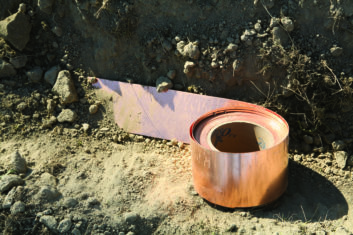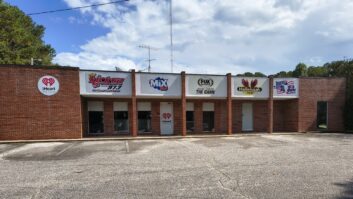Grounding in the broadcast plant is a topic as old as the business itself. Protecting equipment and operations from potential damage caused by lightning is of vital importance when the use of proper and effective grounding methods are considered by working engineers.
 As we all know, direct lightning strikes and their damaging effects cannot be completely controlled or totally eliminated; but we can do a lot to minimize potential damage by employing the best time-tested methods to achieve that goal.
As we all know, direct lightning strikes and their damaging effects cannot be completely controlled or totally eliminated; but we can do a lot to minimize potential damage by employing the best time-tested methods to achieve that goal.
The various “best practice methods” used over time have evolved and improved as more has been learned about what lightning energy is, as well as how and where it travels to release its payload. A single wire running to the power company’s 8-foot ground rod connected to their disconnect panel with #6 wire is hardly an adequate single-point ground reference for a broadcast studio or transmitter facility.
Implementing an effective grounding scheme need not be expensive and is not difficult if you know what to use and where to install it. If you haven’t thought about or reviewed this issue lately regarding your own facility, keep reading.
EVERY SITE UNIQUE
The Copper Development Association a is a not-for-profit trade organization representing the copper industry to promote research and education for industry and business in proper use and implementation of copper products including best practices for energy efficiency, power quality maintenance, wiring and grounding as well as NEC adherence.
Staff from the CDA have presented talks and seminars on grounding and other electrical matters many times at NAB Shows and Ennes workshops and have a paper titled “Proper Grounding and Bonding Are Essential to Uptime.”
Grounding and bonding, including how equipment is connected, is fundamental to an electrical system. It’s like the importance of a building’s foundation. Proper grounding and bonding is cost-effective, often with paybacks under one year. But there is no single solution that applies to every facility.
Each site and design is unique. The quality of local ground characteristics will vary. Rock piles and deep sand need a lot more grounding augmentation than sites surrounded by good topsoil. Proximity to a water source also is important.
[Pragmatics 101: The Big Picture of the Small End of Power Generation]
Typically a single point of ground reference for a given facility is preferred, and that includes the power company’s disconnect panel ground reference. The use of multiple independent grounds can be disastrous since resistance and potential difference values between them invite additional lightning discharge conduits.
The primary goal of any grounding scheme is to minimize the resistance between the master ground reference and all of the facility’s equipment, including transmitters, rack cabinets, cabling and transmission line shields and cable trays as well as connections to outside equipment over waveguide bridges at tower bases.
However those connections should not be grounded to the tower(s) themselves. Towers should have their own ground system reference, including the guy wire anchors to isolate and prevent lightning energy strikes to the tower from reaching the tower base connections and traveling to the building.
HOW MUCH IS ENOUGH?
The question is often asked, “How much grounding is enough to be effective”?
The CDA case study cites 5 ohms or less from the ground reference to the surrounding ground as the IEEE suggested target value. Sensitive facilities, especially in high lightning zones, should strive for 1 ohm or even less if possible.
The other goal is to configure the grounding connections such that any incoming lightning-induced energy from the outside traveling the power lines or transmission cables will be shunted to ground before it can enter the building. Those ground connections need to be substantially low impedance so larger wire sizes and/or copper straps are recommended to handle larger currents.
All connections exposed to the outside elements should be exothermic or cad-welded. If mechanical connections are used, all-copper or stainless steel hardware should be used. All connections need to be inspected annually to verify they are still clean, tight and secure and the bonding has not deteriorated.
Control, communications and low-voltage wiring needs to be routed away from the common facility “halo” ground wire runner as well as power and transmission lines that run to the outside so they cannot induce lightning energy that may enter the building along those conduits. The use of 4/0 stranded copper wire connecting equipment and transmission lines to wall-mounted copper grounding plates as well as wide copper strap running between cabinets along the floor typically is employed. Anything smaller is deemed inadequate for most installations.
[Field Service Tips: Grounding]
CDA has given presentations about facility case histories from Florida and New Jersey that had suffered extensive lightning damage before the recommended grounding methods were implemented. Pictures of before-and-after hardware environments illustrate how the additional grounding interconnections were best routed and installed.
While adhering to NEC standards for hardware installation guidance is recommended, some of the NEC codes will not always apply or adequately address specific site needs. CDA case studies discuss such unique situations. For all facilities, grounding and wiring is usually cost-effective, especially during the construction phase of a facility. Lightning damage to equipment and resulting downtime are usually far more costly than corrections to the electrical installation.
The Copper Development Association’s website has many articles and videos on wiring, research, case histories on grounding, connectability and a host of other topics. Most can be downloaded. CDA also offers free seminars to groups like SBE chapters.







